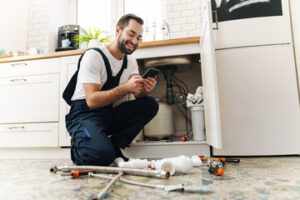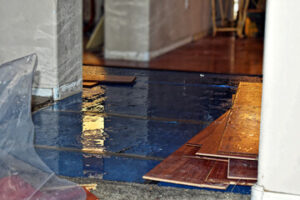Plumbers install, repair, and maintain pipes, fixtures, and appliances such as sinks, toilets, showers, and water heaters. They also inspect and diagnose problems such as leaks, clogs, or malfunctioning equipment.

Plumbers Sarasota work in residential, commercial, and industrial settings. They often collaborate with other professionals, such as construction teams and architects, to ensure plumbing systems are integrated seamlessly into building projects.
Whether in homes, businesses, or industrial settings, plumbing systems are crucial for providing clean water and proper drainage. Plumbers install, repair, and maintain these systems, ensuring they are efficient and safe for occupants. They must adhere to strict safety protocols when working with dangerous materials and in confined spaces. A career as a plumber is rewarding for those who enjoy working with their hands and solving problems.
If your sink faucet is leaking, the first step is to remove the handle. Shut off the water supply and cover or close the drain to prevent losing any parts. Locate the set screw hole behind the handle, and use a wrench to loosen it. You may need to pry off the decorative cap or screw if it is stuck, but once removed, the handle should pull off. If it does not, there is a clip or retaining nut that must be removed to access the cartridge or disk.
If you cannot locate the leak source, shut off the water and remove the aerator to clean it. Replace the washer and o-rings, if necessary, and test for leaks. If the faucet still leaks, you may need to replace the valve stem assembly or the ceramic disks. Once the faucet is reassembled, turn on the water and test for any remaining leaks. If the leaking persists, the problem is likely elsewhere. If this is the case, contact a professional for further inspection and repair. Leaving a leaky faucet unattended can waste more than 3,000 gallons of water per year.
Cleaning the Faucet
Faucets in kitchens and bathrooms can accumulate hard water residue, mineral deposits, and stains over time. Cleaning them can prevent buildup and ensure that your faucet’s water flow is working properly. You can clean your faucet in several different ways, but it’s important to be sure that you don’t use harsh abrasives or chemicals that could damage the fixture and contaminate your home’s water supply.
If you’re looking for a quick way to remove some light buildup or stains from your bathroom faucet, try wiping it down with a microfiber cloth and water. For more stubborn grime, you can use a non-abrasive cleaner that’s safe for your faucet’s finish. Avoid abrasive cleaners, metal scrub pads, or steel wool as they can scratch and dull the surface of your faucet.
White vinegar is a natural and affordable option that can remove hard water deposits, lime scale, or other stains. For a deeper clean, you can soak the faucet in a solution of white vinegar and water, or use a commercial product designed to remove hard water deposits and stains from your faucet. If you decide to use a commercial cleaner, read the instructions carefully so that you don’t leave the cleaner on for too long or use a concentration higher than recommended.
Alternatively, you can clean your bathroom sink faucet head by soaking it in a mixture of water and baking soda. This will create a safe and effective cleaning paste that you can scrub with an old toothbrush or other small cleaning tool. After scrubbing, rinse the faucet head thoroughly with clean water and allow it to dry before reattaching it to your sink.
If you notice that your faucet is leaking, it’s important to act quickly. Leaking faucets can lead to excessive water waste, high water bills, and potential damage to your plumbing system. Regular inspections can help catch leaks early and prevent them from escalating into larger problems.
To check for a leaky faucet, turn off all the water in your home and look for wet spots on the floor around the faucet. If you see any, there may be a problem with the seals around the pipe joints or in your faucet itself.
Inspecting the Faucet
The plumbing systems in homes, commercial buildings, and industrial facilities require regular maintenance to function properly. Plumbers install, inspect, and repair these networks of pipes and fixtures. Their duties include identifying issues, cleaning drains, and replacing worn-out parts. They also ensure that water and sewage systems comply with local and national regulations. Plumbers often work on construction sites, where they install piping and appliances according to blueprints and building specifications.
A dripping faucet wastes water and increases utility bills. Fixing the leak stops this unnecessary waste and helps prevent property damage. It is also important for landlords to address these issues in their rental units. Integrating submetering into these systems enables owners to track water usage, detect leaks quickly, and promote responsible water consumption among tenants.
Inspecting the Faucet
The first step in repairing a leaky faucet is to remove the handle and expose the internal components. This is usually done by removing a decorative cap or screw that secures the handle. After the handle is removed, a plumber can access the washers, springs, and O-rings that seal the connection between the faucet handle and spout. These components wear out over time due to constant use and water pressure changes. Once these components are weakened, they can let water escape through small gaps. Plumbers can replace these parts to restore the original seal and prevent future leaks.
Another part of the inspection process is examining the spout for signs of rust or mineral build-up. These deposits can interfere with proper water flow and cause clogs. A plumber may need to scrub these deposits with a brush and special cleaners to remove them. Plumbers should always wear rubber gloves when handling these chemicals. They should also be careful not to over-tighten connections, as this can lead to leaking.
Once the plumbing repairs are completed, a plumber should thoroughly test the unit to make sure it is functioning correctly. This is a critical step because it is impossible to know whether the new parts are durable enough to stand up to long-term use until they are actually in place and being used. In addition to testing the water pressure and temperature, a plumber should also check that all connections are tight and secure. Any loose connections should be retightened using plumber’s tape to prevent leaks and reduce the risk of future problems.
Repairing the Faucet
A leaking faucet may seem like a minor nuisance at first, but the constant dripping can cause water damage to your home. Not only is it an annoying sound, but it can also lead to puddles under the sink, mold and mildew, and higher water bills. Fortunately, fixing a leaky faucet isn’t difficult and can save you money in the long run.
The most important step in repairing a leaky faucet is turning off the water supply valves under your sink. Turning off the water before you start working will help prevent any accidental spills or flooding. Once the water is off, you can remove the handle and inspect the parts to determine what needs to be replaced. For example, you might need a new washer or O-ring, a replacement cartridge, or a new stem seat.
Before replacing any parts, you should try to clean them first. For a standard faucet, this means using a cloth or brush to remove any buildup around the exterior of the handle and the base of the faucet. You can also use a vinegar solution to soak and clean the handle. For more stubborn deposits, you can use a metal cleaner or rust-removal product.
Depending on the type of faucet, you might need to remove the handle completely to access the valve assembly. For this, you’ll need to either pry off the decorative cap or unscrew the screw. Once the handle is removed, you can remove the temperature indicator and use a wrench or pliers to unscrew the nut or set screw that holds the handle on the valve stem. Once you’ve removed the handle, you can inspect the assembly for any signs of corrosion or damage and replace any necessary parts.
If the leaking persists, you may need to replace the entire faucet assembly. This can be done by shutting off the water supply valves under your sink, removing the old assembly, and installing the new one. Once you’ve installed the new assembly, turn the water supply back on slowly to test for leaks and ensure everything is in place.

